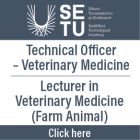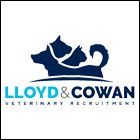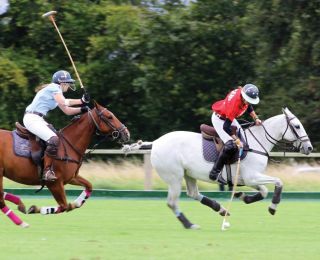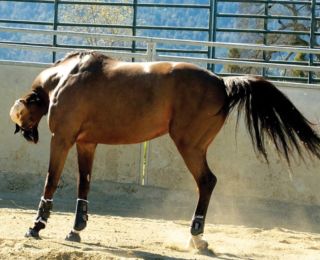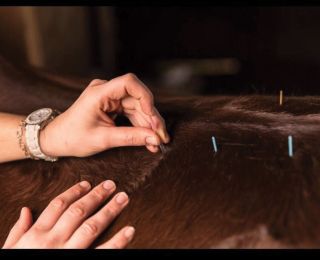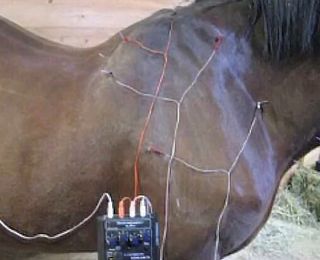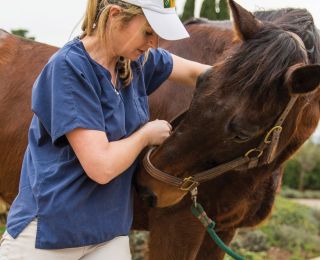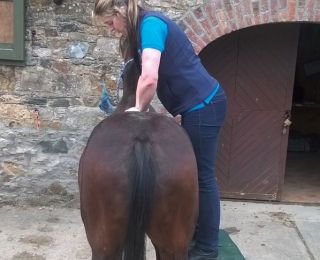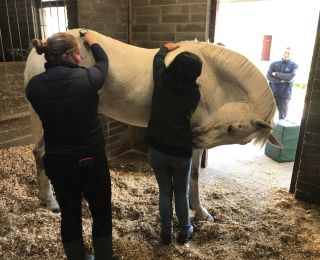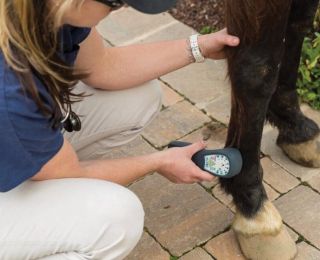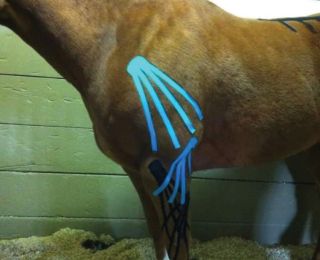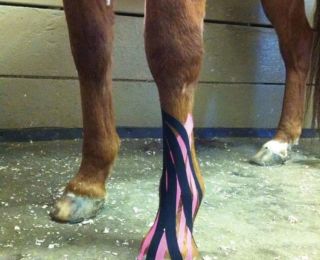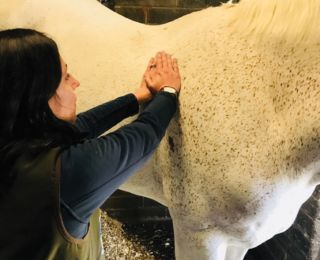Focus - Herd health - November 2018
Integrative equine sports medicine
Sinead Devine MVB cVMA, certified animal chiropractor and assistant professor in Equine Clinical Studies, University College Dublin examines the increased use of complementary and alternative methods to manage lameness conditions in equines and decrease the risk of re-injury
Musculoskeletal disorders are the most common cause of wastage in equine athletes and lameness cases can be among the most challenging faced by equine practitioners. Horse owners are increasingly exploring complementary and alternative methods to manage lameness conditions and decrease the risk of re-injury. However, such complementary and alternative therapies are very controversial within veterinary medicine. Evidence-based veterinary medicine is defined as the use of current best evidence in making clinical decisions. While there is no single well-defined study answering all the questions on equine complementary therapies, more recently there are some well-designed, blinded, randomised, controlled studies done in the US that support the use of these therapies. For the equine clinician, is it useful to know what treatments exist and, possibly, where appropriate, to integrate complementary modalities into more traditional practise, on a case-by-case basis. Similarly, in the world of human medicine, evidence-based nonpharmacologic strategies are being sought for comprehensive pain care.
Sport horse medicine in the US has embraced this integrative approach for the past decade, especially for competing horses, who suffer from chronic issues, eg. stiff joints, sore back, stiff neck, which compromise horse welfare and performance. Management of these athletes using acupuncture, chiropractic, laser therapy and massage can help prevent progression of these issues into breakdown injuries. Consultations begin with a thorough clinical exam and full work up of the lameness or performance issue, with imaging as appropriate. A diagnostic acupressure examination may then be performed.
Acupuncture
Acupuncture, from the Latin acus (needle) and pungere (to puncture), has been used to treat various medical conditions in humans for over 3,000 years. It is thought that people originally sought to relieve or alleviate pain through pressure from their fingers and this developed to the use of needles by the Neolithic Chinese. We now approach acupuncture from a scientific platform, given that abundant information exists concerning the connections between acupuncture anatomy, nerve stimulation, and neuromodulation of the peripheral, central and autonomic nervous system. Acupuncture points occur along the meridians all over the body and decreased electrical resistance can be measured at these points, needle insertion causes microtrauma and neurovascular reactions.
Modern research shows that acupuncture point locations are in areas with a high density of free nerve endings (nervi vasorum), mast cells, small arterioles and lymphatic vessels. Some acupuncture points are located where nerve bundles penetrate the fascia, some where the cranial nerves exit the skull. The mechanism of action of acupuncture includes local, spinal, central and visceral effects. Stimulation at acupoints causes release of substance P and histamine. By stimulating endorphin, such as encephalin and adynorphin, acupuncture can modulate pain (neural-opiate theory). Acupuncture also causes the mid-brain to produce monoamine, a neurotransmitter that can in turn further inhibit pain. Needle insertion also stimulates mechanoreceptors, this activation can augment analgesia. Additionally, by causing the core region of the hypothalamus to release and distribute beta-endorphins, acupuncture influences the autonomic nervous system. Most horses tolerate insertion of acupuncture needles, they are not sedated for the assessment or the treatment. Aquapuncture is also described where saline or vitamin B12 is injected at particular points allowing the fluid to further treat the point with pressure over a period of time as it is absorbed.
Acupuncture is often used in horses to treat neck and back pain, it can help where horses are compensating due to the effects of arthritis or navicular syndrome. UC Davis researchers have proven the use of acupressure points being used as a diagnostic tool for lameness. Further research is ongoing in its use to locate the site of most severe pain, particularly helpful in cases where multiple joints are affected. Reactivity at some points can help differentiate between hock or stifle pain. In some cases, acupuncture can help manage chronic on-going performance issues using less anti-inflammatory or intra-articular medications and keeping horses in competition, especially at FEI level. Treatment is possible throughout competition and is also useful in acute cases, eg. endurance horses immediately after competition. Electroacupuncture is a form of acupuncture where a small electric current is passed between pairs of acupuncture needles. During strong, low frequency electrical stimulation of needles in muscle, vigourous muscle contraction can occur. Some sensitive horses are uncomfortable with this stimulation, so it is always advised to start at a very low frequency. Transcutaneous electrical nerve stimulation (TENS) units are portable, battery-operated devices containing electrodes, within pads, that are attached to the skin surface. The popularity of TENS units for human patients has increased interest within the equestrian community, but long equine hair and a paucity of evidence means we should be cautious of anecdotal claims!
Contraindications for acupuncture include any evidence of dermatitis or cellulitis on the horse’s skin, the horse should be dry and brushed clean prior to beginning treatment. Acupuncture needles can break while in situ, depending on patient movement etc and so horses should be supervised during treatment. Horses may try to bite at needles and may begin to kick out 5-10 minutes into treatment, even if they were initially relaxed, owner and vet should be aware of this.
Chiropractic
Chiropractic is a manual therapy, often called ‘spinal manipulation’, the goal of which is to ensure smooth, coordinated movement of all spinal segments to optimise spinal joint neuromuscular function. ‘Chiropractic’ comes from the Greek words ‘praxis’ and ‘cheir’ meaning to practice or treat using hands. Chiropractic care for humans as a profession began in 1910 in the US and is now accepted by many human health insurance companies in Ireland.
The equine chiropractic examination is to assess for reduced range of motion at a joint, called the ‘vertebral subluxation complex’. The fundamental principles are that hypomobility at the joint can lead to dysfunction and may be corrected with a chiropractic ‘adjustment’, a low amplitude, high velocity thrust in the specific joint plane. There is a common misconception, among owners, that there is a ‘rib out’ or that a bone is ‘out of place’, which is entirely false! The chiropractic adjustment is to restore optimal range of motion of the joint, which may subsequently alleviate inflammation and pressure on surrounding nerves and soft tissues. The practitioner must have a very accurate knowledge of spinal anatomy, the joint plane varies with location on the spine and adjustments must be performed on this plane to avoid trauma. Horses are also not sedated for this treatment. Concerns of owners requesting chiropractic care often include neck stiffness, head shaking, forelimb lameness, poor transitions, reduced suspension, reduced mobility/engagement in the back or pelvis. Protocols vary per case but may include weekly assessments and adjustments for three to four weeks for particular injuries.
Low-level laser therapy
Therapeutic lasers have been used on the equine athlete since the 80s in the US but are increasing in popularity in the past five years. Low-level laser therapy, or ‘cold laser therapy’ is a form of photo-therapy used to stimulate tissue repair and provide pain management. Focused red and infrared light stimulate tissue, at and below skin surface (and is also used at acupuncture points). In photobiomodulation, the biochemical effect of the low-level pulsed laser light, increases the production of cellular energy at the mitochondrial level and thus promotes cellular regeneration, production of collagen for tissue repair and vascular dilation and synthesis for better circulation.
Massage
The mechanism of action for massage therapy is not fully understood. Massage therapy may induce local biochemical changes that modulate local blood flow and regulate oxygenation in muscles, subsequently influencing neural activity at the spinal cord segmental level, thereby modulating the activities of subcortical nuclei that influence both mood and pain perception. Equine massage varies in intensity from light pressure to deep ‘interrogation’ of the musculature. The bulk and weight of a horse actually does not necessitate that initial manipulation be deep and powerful, in fact gentle progression and sensitivity should be used. Massage movements should go with the lay of the hair or sometimes transversely, but not counter. Alternative working at both superficial and deep level is often performed, progressively enlarging the examined area, to assess the variety of tensions at different levels. Some specific techniques include: with the flat of the hands, with fingertips, with elbow, mobilizing massage, drainage massage (to improve lymphatic drainage). Circular movements around a cramped muscle are made by working the fingers together as a solid unit on the skin. Kinesiotaping is sometimes used in conjunction with physical therapy and stretching.
Other treatment modalities requested by clients may include Cranio-saccral therapy, described as a ‘light-touch hands-on therapy’. No equine veterinary studies yet exist to support the usefulness of this technique. Chinese herbs, homeopathy and aromatherapy are also requested by clients and current literature does not support their use for any specific equine conditions. Use of any such unregulated products may cross react or act as masking agents on drug tests and so strict caution should be exercised for competing horses.
Integrative sport horse medicine can hugely benefit our equine patients, these modalities should complement our conventional or routine veterinary care, as they are adjuncts to, not a replacement for conventional veterinary medicine. In a circle of care between the horse, owner, trainer and vet, integrative medicine can help combine complementary therapies for improved patient outcomes.
- Current status of Equine Integrative Medicine Techniques Used in Equine Practice Kevin Haussler Journal of Equine Veterinary Science Vol 29 (August 2009).
- Acupuncture and Equine Rehabilitation Sarah le Jeune et al Veterinary Clinics of North America vol 32 (2016).
- Use of acupuncture in equine reproduction W.A. Schofield Theriogenology (2008).
- Acupuncture in equine stifle disease Michelotto et al Journal of Equine Veterinary Science vol 24 (2014).
- Successful Practice of Electroacupuncture Analgesia in Equine Surgery Sheta et al JAMS VOL 8 (2015).
- Equine Acupuncture :Incorporation Into Lameness Diagnosis and Treatment Allen M Shoen AAEP Proceedings (2000).
- Effect of chiropractic manipulations on the kinematics of back and limbs in horses with clinically diagnosed back problems Alvarez et al Equine Veterinary Journal vol 40 (2008).
- Evaluating the Benefits of Equine Massage Therapy: A Review of the Evidence and Current Practices Scott M Journal of Equine Veterinary Science vol 29 (2009).
- Physiotherarpy Asssessment for the Equine Athlete Goff L Veterinary Clinics of North America-Equine Practice, vol 32 (2016).


